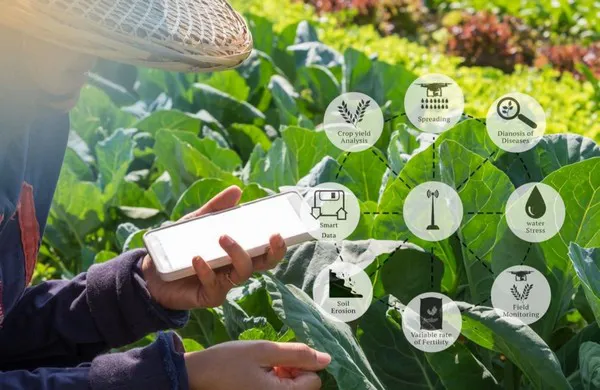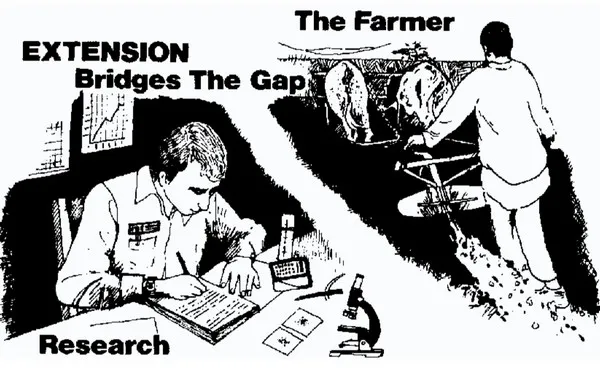The USDA extension services, along with the various State Departments of Agriculture and Land Grant universities provide tremendous support to traditional farmers and ranchers. For decades these services have proven to be extremely valuable to agriculture production and play a critical role in helping them overcome challenges and constraints in running operations.
USD cooperative extension services
“Cooperative Extension Service offices are conveniently located in courthouses, post offices, or other local government buildings to improve the quality of people's lives by providing research-based knowledge to strengthen the social, economic, and environmental well-being of families, communities, and agriculture enterprises. Extension experts focus on, among other subjects, food safety and quality, the plight of young children, revitalizing rural America, sustainable agriculture, and waste management.”

Land Grant Universities
USDA advances knowledge for agriculture, the environment, human health and well-being, and communities by supporting research programs in the Land-Grant University System and other partner organizations.” All universities engage in research and teaching, but the nation's more than 100 land-grant colleges and universities have a third critical mission — extension services. Through extension, land-grant colleges and universities bring vital, practical information to agricultural producers, small business owners, consumers, families, and young people.
Through evidence-based science and modern technologies, these services present farmers and ranchers with information and advice-giving them on the skillset and knowledge they need to run a successful and profitable field farm. It is important to remember extension services work with farmers, not for them. The goal of these services is to bring new findings and research to the people who can put them into practice. While there are Land-grant universities located in every state in the U.S. The services are geared toward traditional farming such as field farms and ranches.

Where does CEA come into play?
While these services work to keep farmers educated on new and emerging technologies, challenges, and research there is a missing piece to the puzzle which is the shift from traditional farming to indoor farming. The indoor farming technology market was valued at $23.75 billion in 2016 and is projected to reach $40.25 billion by the end of 2022.
As a portion of the farming industry moves indoors, vertical farms and greenhouses will produce a higher percentage of food grown in the US. That leaves us questioning how can the land grant university and extension service programs become more responsive to the unique needs of indoor farms?
Over the last decade, many states and universities across the country have implemented projects focused on the research and development of indoor farming.
For example:
Texas A&M University’s Urban Farm United (TUFU) is using vertical farming to produce high-value/specialty crops to help feed students.
The University of Arizona’s Controlled Environment Agriculture Center (UA-CEAC) and technology/industry collaborators have come together to launch a new multi-tier vertical farm (VF) based research, education, and outreach facility (UAgFarm) at the UA-CEAC.
The Ohio State Controlled Environment Agricultural Research Complex is a research facility for the College of Food, Agricultural, and Environmental Sciences. This research facility will help develop transformative solutions to create greater food security through improvements in agricultural vitality. The facility will contain a 24,000 SqFt processing lab and head house to support the 80,000+ SqFt of growing space for both research and production.
As universities and states put more focus on the research and development of vertical farming it has proven one thing, that there is an increased interest to use indoor farming as a new technology to grow produce. Currently the extension services have focused on offering advice on traditional agriculture methods and supporting farmers with challenges around water consumption, soil degradation, invasive species, bugs, food transportation, pollution from fertilizers, and pesticides, and efficiency and yield. Whereas vertical farms and greenhouses face different challenges. Obstacles such as pest management, nutrient recipes, nutrient deficiency, crop quality, post-harvest techniques and the maintenance and repair of high-tech growing equipment (LED lights, fertigators, water treatment systems, sensors).
A limited amount of extension service resources are directed to vertical farms and greenhouses, leaving these modern farmers with nowhere to turn to when facing these types of challenges. For the CEA industry to continue to grow we must develop an entire eco-system, from capital to extension service support. Although extension services are a great resource for traditional farmers there is a growing need for extension service support for the growing numbers of indoor farms across the country. Services and support that is geared toward a more sustainable way of growing year-round, that can produce more crop per drop, improving the way we feed a growing global population.
 Green Sense Farms
Green Sense Farms6525 Daniel Burnham Drive, Suite B
Portage, IN 46368-1793
Phone: 219-762-9990
Fax: 219-762-9992
www.greensensefarms.com
